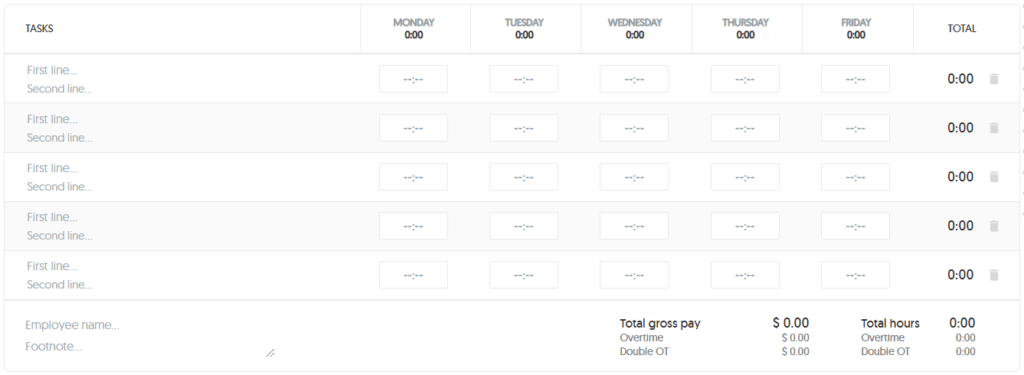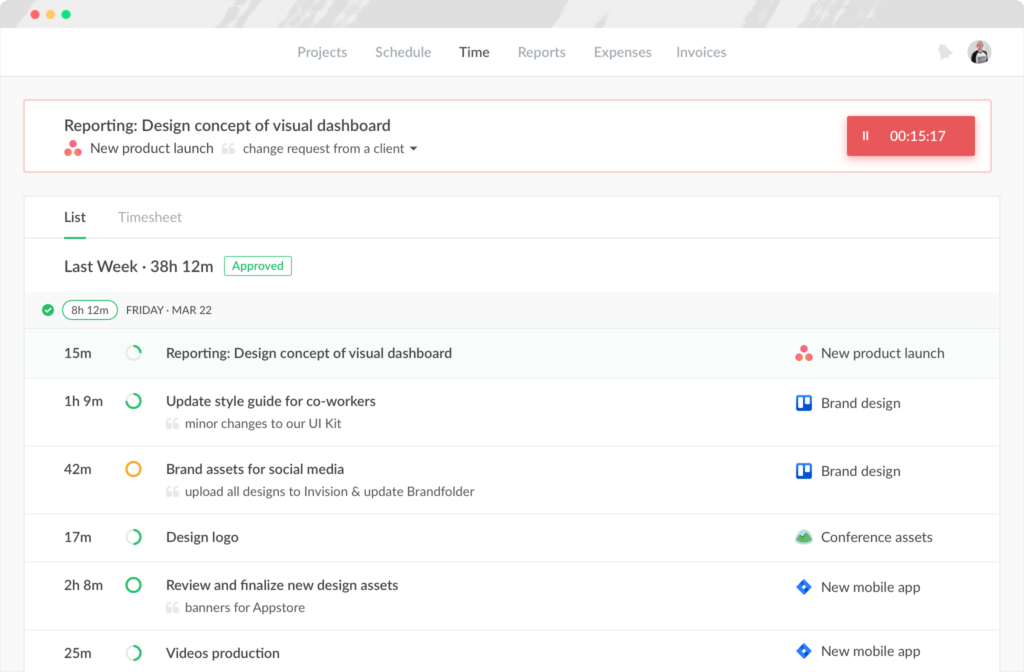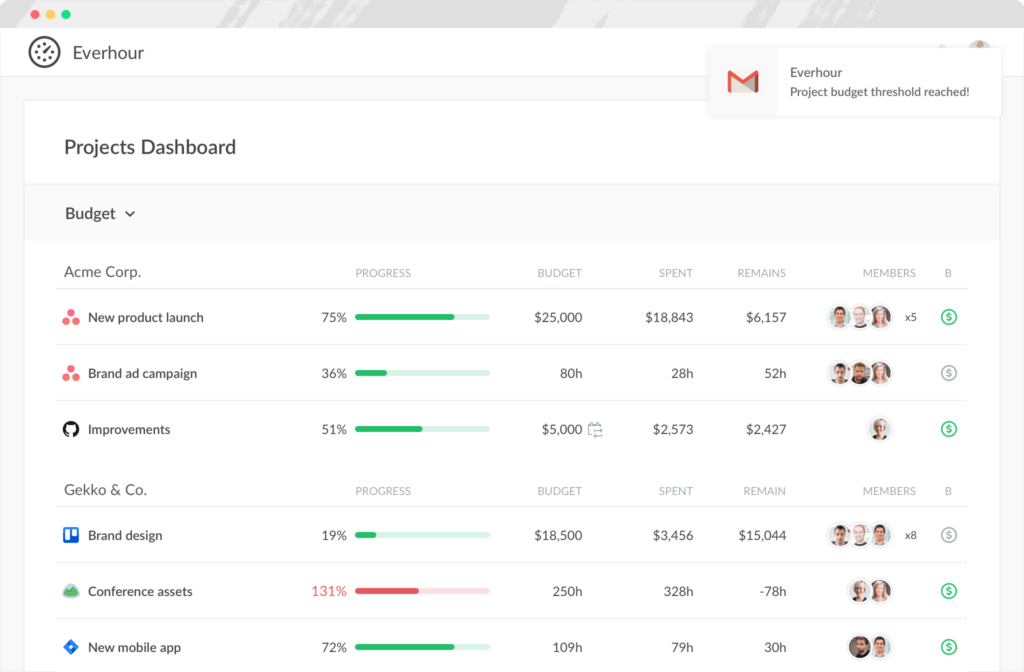Part-Time vs Full-Time: Understanding Key Differences and Choosing the Best Option

Think the decision whether you need to hire a part-time vs full-time member of staff is as simple as the hours they work? Think again. Deciding if your new team member should be working part-time hours or full-time hours is so much more than the numbers on their timesheet.
Distinguishing between part-time vs full-time is essential to understanding how to define your obligations to your employees, including salary, benefits, vacation time, and more.
Fail to label your employees correctly, and you could leave your company open to penalties or fines. In this article, we’ll help you uncover why knowing the difference between part-time vs full time, including:
– What part time vs full time work means
– Factor you need to consider: exempt, non-exempt, overtime, and more
– How to decide who you need
– Which tools can help (including Basecamp time tracking and the best timesheet apps)
Let’s dive in!
Key Differences Between Full-Time and Part-Time Jobs
In short, full-time hours employment is 35-40 hours per week, while part-time hours employment amounts to 30-35 hours per week. The distinction between full-time and part-time engagement is delineated by the allocation of hours and resources. While certain organizations define full-time involvement as dedicating 40 hours per week to a project, others might confer this status upon team members contributing as little as 32 hours weekly. Conversely, individuals contributing 30 hours or fewer per week are typically categorized as part-time contributors to the project.
So in general, a full-time employee works 30-40 hours per week (130 hours per month), while a part-time employee, on average, works fewer than 30 hours per week (consequently, fewer than 130 hours a month)
The number of part-time and full-time employees a company has affects whether the employer is classified as a small employer (SE) or an applicable large employer (ALE). SEs and ALEs have different obligations.
It is important to distinguish between full-time and part-time employees because full-time employees receive benefits while, generally, part-time employees do not. For example, part-time employees typically don’t receive paid time off (such as vacation or holiday pay), employee benefits (health insurance), and part-time employees are often excluded from participation in employer retirement plans.
If you want to quickly weigh the pros and cons of part-time vs full-time workers, you will find this video helpful:
For an in-depth review of the differences between full-time and part-time (and how to set these differences in your company), stay with us, and let’s dive into the finer details!
What is considered full-time?
In short and in general, in the US, full-time work is commonly considered to be 32-40 hours or more working time per week.
However, depending on what definition you look at, you may see different numbers for full-time hours. For example, the Bureau of Labor Statistics definition of full-time considers this type of employment to be 35+ hours per week. Meanwhile, the Affordable Care Act defines a full-time worker as someone who is employed more than 30 hours a week.
How many hours is full-time is just one part of the part-time vs full-time puzzle. Defining the status of full time or part-time workers means taking into consideration:
1) Is the work permanent, temporary, seasonal?
If the role is permanent and more than 30 hours, your employee is likely to be full-time. For temporary and seasonal workers, it will depend on the type of contact you have with them. In any case, you need to follow Federal and Local employment laws for employment conditions and benefits.
2) Do your employees receive benefits?
Paid time off, health insurance, private retirement plans – all these are benefits companies normally offer to full-time employees. However, part-time employees may still be eligible for certain benefits on a pro-rata basis. Check your local state employment laws. In some instances, you may be discriminating if you do not offer part-time employees benefits. For example, Hawaii’s Prepaid Health Care Law states that employees that work over 20 hours per week should be provided with health insurance.
3) Are you a small employer (SE) or an applicable large employer (ALE)?
If you have more than 50 employees or equivalents that work full time, you will be classified as an ALE (Applicable Large Employer). This obliges you to offer certain healthcare benefits to your employees under the Affordable Care Act (ACA). SEs are not exempt from the ACA but have different requirements.
Full-time hours Q&A
Below we answer some of the most frequently asked questions about employing full-time staff for your company.
❓ Does it make a difference whether I pay my employees a salary or by the hour?
Although salaried vs hourly debate often appears when it comes to the full time vs part-time discussion, how you pay your employee doesn’t mean much in terms of how they are classified. When paying salaried employees, the amount stated in the contract will be defined as a monthly payment and paid on a monthly or 4-weekly basis. Alternatively, this might be seen as a yearly payment, which will be divided and paid based on how many weeks or months an employee has worked.
❓ Is my hourly employee full time?
This depends on how many hours a week they work for you. If on average, your employee has worked more than 30+ hours a week they may be classed as full time or a full-time equivalent, meaning you may be liable for benefits and other contributions under law. In case you need to accurately calculate how many hours your employee has worked in any given week, try our free online timesheet.

If you have a zero-hour contract (flexible) with your employees, you will still be bound by employment law (more on that later) but may not have to offer sick pay, a pension, parental leave, or other specific criteria.
When debating whether hourly or salaried is the way to go, pay attention to whether your employee will be classified as exempt or non-exempt under the Fair Labor Standards Act (FLSA).
❓ What are exempt and non-exempt employees and why does it matter?
Exempt and non-exempt employees are two categories defined under the Fair Labor Standards Act (FLSA). Here’s a quick table to help you understand how your employees should be classified:
| Non-exempt | Exempt |
| Paid either a salary or by an hourly wage | Paid a salary, not an hourly wage |
| Weekly income may vary | Earns over $684 per week |
| Entitled to overtime pay if they work more hours than agreed upon | Does not receive overtime |
| Applies to almost any field of work | Works in a specified job category |
| Duties test need not met | Meets Duties Test criteria |
| Entitled to overtime pay | Not entitled to overtime pay |
Defining your employees as exempt or non-exempt is essential to know whether you should be paying overtime or not.
- Non-exempt employees are covered under the FLSA and should be paid overtime pay.
- Exempt employees are exempt from some of these terms and not entitled to overtime.
Advantages and Disadvantages of Full-Time Employment
In short, the benefits of employing your staff full-time are:
- Stability in outgoings on employees. Each month you will know in advance your spending on your employees, including salaries and benefits. This allows you to plan for the future and consider rewarding dedicated staff with bonuses.
- Reliability of staff for tasks. You always know who will be on hand to take on certain tasks. There’s no need to hunt for a new specialist every time you need something done.
- Dedication to the company. Providing your staff with good working conditions and a stable salary means they are more likely to be loyal to your company.
And the negative aspect of full-time employment could be:
- Liability if the business isn’t going well. If you are locked into a full-time contract with your employees that guarantees hours, then this could be a liability in times of a market dip. You will still need to fulfill the terms of your contract.
- May become complacent due to stability. Occasionally when things are going well, we get used to our position and become complacent. When you have full-time employees, you need to look at innovative ways to motivate them to keep up performance.
- Can find it hard to balance work and life. As your employees become more and more involved in your business, they may risk jeopardizing the life-work balance. Help keep them on track with regular reviews and accurate project management.
Now that we covered what full time means for your business, let’s move on to part-time work.
Part-time employment: the basics
Where is the line between part-time vs full time? How many hours is part-time? And what’re the average part-time hours per week? Let’s take a look at the role of part-time employees in your business and the part-time employment definition.
Exactly How Many Hours Is Considered Part-Time?
Generally speaking, a part-time employee will work fewer than 30 hours per week on average.
Part-time hours Q&A:
Below we’ll explore some of the most frequently asked questions about employing part-time staff for your company and what this means for you.
❓ Do you need to pay your staff benefits if they are part-time?
Many part-time employees are not entitled to workplace benefits. This means cost savings for many employers. But, there is an exception. If your workplace has 50+ employees, then you are obliged to provide 95% of them who work for 30 hours and more with health insurance. This falls under the Affordable Care Act.
❓ What is considered part-time?
Part-time workers often enjoy more flexible schedules than full-time employees. This leaves them lots of time for outside work activities, or even a second job.
Types of part-time work schedules include:
- Freelance – working a remote part-time job or on-site, freelancers are temporarily part of your team.
- On-call – generally confined to the emergency service sector. On-call employees are required to be there as and when needed, but may not actively engage in any work.
- Split schedule – got a school pickup to take care of or other responsibilities. The split schedule allows your employees to fit their work around their lives.
- Alternating schedule – your employees’ plan may differ than it was before due to numerous circumstances. These are accommodations made to fit their new lives.
- Job-share – your employee may share their role and responsibilities with another team member due to other outside work commitments.
- Remote – no matter where you are or where your part-time employee is, remote working is one way to get things done without the fuss (with the help of remote work management software).
❓ Which types of jobs are most suitable for part-time work?
Almost all types of work could be suitable for transfer to part-time roles. However, some of the most popular include health and social care, accounting, computer programming, editing, graphic design, waitressing, and more.
Part-time work may be undertaken to supplement the employee’s main wage or as a standalone activity for an employee who is part-time by choice.
Advantages and Disadvantages of Part-Time Work
Some of the advantages of employing part-time staff include:
- Flexibility for the employee and employer. When your employees are part-time, this offers versatility to your business. You can employ a more diverse range of staff for smaller tasks. For example, a part-time designer and a part-time copywriter, if you don’t need someone full-time. Your employee is also freer to pursue additional opportunities and expand their skill set.
- Less cost to your business. Generally, with part-time vs full-time employees, you won’t be required to pay additional benefits. This means you save in the financial department.
- Provides an extra set of hands to your team. Whether your part-time is in-office or you’re offering remote part-time jobs opportunities, your employee is an extra set of hands for your full-time staff. They can reduce the pressure on the team and get them working more efficiently.
There are definitely some disadvantages to consider, too, when it comes to employing part-time workers:
- May have other commitments. While going part-time does allow your employees the opportunity to expand their skill set, the downside is they may not have enough time to commit to your project.
- Fluctuating monthly costs. Depending on the type of contract you have with your employee, you may be paying them fluctuating costs due to the hours they worked that month. You need to carefully monitor hours-worked with a time tracker to ensure accuracy.
- Questionable loyalty and consistency. When you’re not paying their full-time salary, your part-timers may be open to looking to opportunities elsewhere. They may find the grass is greener on the other side. And this could leave you short-handed.
Now that we learned about part-time vs full-time employment, let’s compare them.
Differences Between Part-Time vs Full-Time Employees: Comparison Table
Knowing the difference between part-time vs full-time is essential to your staffing planning. Below we break it down for you in a handy table that compares these two types for you.
| Part-Time Employee | Full-Time Employee | Why does this matter? | |
| Does your employee receive benefits? | These workers generally don’t receive benefits. It is often at the digression of the employer. However, some may be entitled. | Most businesses are required to offer their full-time employees benefits. Additional benefits, such as stock options, may be offered by the decision of the employer. | Benefits are an attractive feature for employees. The security they provide can help your business land high-quality talent. However, on the other hand, they can be costly. |
| Do I need to offer health insurance? | In some cases, you may be required to offer your employees health insurance under the ACA. | For ALEs that have more than 50 full-time staff and full-time equivalents, the ACA states that you must provide health insurance. For SEs, you need to check for your individual business. | If you fail to offer health insurance when you should, you may face penalties. However, conversely, overpaying when you don’t have to can impact your profits and you may consider offering on a case-by-case basis. |
| Do I need to follow the Federal Fair Labor Standards Act (FLSA)? | Yes, having part-time staff does not exempt you from the terms of the FLSA. | Yes, full-time employees are covered under the FLSA. | The FLSA is the bottom line for employers. Part time or full time, you are required to follow its terms. |
| Do I need to follow local employment laws? | Yes. | Yes. | You should always consult your local employment laws, alongside federal employment laws, such as the FLSA. These may differ in terms of minimum salary. In which case, you are required to pay whichever rate is higher. |
| Does exempt vs non-exempt matter for my employees? And do I need to pay overtime? | Generally, part-time workers are non-exempt. You will be required to pay both minimum wage per hour and overtime. | Full-time workers are generally exempt, so you may not have to pay overtime and will pay based on salary. | Exempt or Non-exempt status should be considered separately from part-time vs full-time employment status. Always recheck for your individual case. |
Part-Time vs Full-Time: What You Need to Know to Make the Right Choice
We’ve covered what full-time vs part-time means for you and your business… but what are the criteria you should base your decision on? If you’re still torn, here is the list of the factors you need to consider.
The legal
No matter which type of employment style you choose, you will be bound by one thing – the Fair Labor Standards Act (FLSA). Developed in 1938, the FLSA defines workers’ rights and employers’ responsibilities.
It covers terms, such as exempt and non-exempt, rules and compliance, and more. When employing a member of staff, this is your go-to guide for doing things right. Here are some of the main points to pay attention to:
- Minimum wage – although this may vary from state to state (check your local legislation), as of July 24, 2009, the US minimum wage is $7.25 per hour. This is the absolute minimum you can pay your employees if they work by the hour. Note: If the state minimum is higher, you must pay this amount instead.
- Overtime – if your employees are non-exempt and entitled to overtime pay, you need to build this into your calculations. Generally, overtime is paid at time and a half for any hours worked after 40 hours.
- Hours worked and record-keeping – as an employer, you are required to keep an accurate record of employees’ hours worked. This includes all hours on-premises, at the workplace (even when working from home), and on duty. For this, a time tracker will help you.
Don’t forget the ACA
As an employer, there’s one additional piece of legislation you’ll need to take note of – the Affordable Care Act. If you have more than 50 full-time employees, you are an “applicable large employer” or ALE. This means you should provide health insurance to your employees.
Less than 50 full-time employees or equivalents and you’re probably a Small Employer (SE).
However, calculating if you have 50 full-time employees is not so straight forward as you initially think. To do this involves adding all your employees’ hours together and dividing them.
Need some help? The government has developed a special calculator to do this for you. Just input the hours – you can calculate them with Everhour – and see if you’re eligible to pay ACA.
The practical
With the legal out of the way, now you need to find systems and procedures within your organization to make full-time or part-time work for you. This comes down to three factors – project management, time monitoring, and budgeting.
Project management methodologies
Before you launch your awesome project, you’ll need a system and structure to make it work. Also known as your project management methodology. That applies whether you’re going Agile, Waterfall, or more traditional. This defines the methodology by which you will work and then allows you to plan your staffing needs more accurately.
By deciding this key point, you’ll be able to define which staff you need – full-time or part-time and approximately when in the project you need them. You can even hire freelancers or external experts as and when required.
Make time management a priority
Next up is time management. If you’re already a time tracking pro and experienced leader, you’ll have some idea of how long it takes to get work done. But if you’re newish or taking on a brand new project, there will be some trial and error as you evaluate working hours. In either case, using a time tracker helps you get to grips with:
- how much time is needed to complete a task
- the extent to which your employees are busy
- how much work they can afford to take on before you hire someone else.

Budget like a pro
Now, what about that budget? Budgeting is a vital part of any company, without accurate finance-keeping, you will find your business is ineffective and essentially more a hobby than a business. You need to make sure your company is profitable. Your budget not only dictates how many employees you need to get work done but also how valuable their time is for you. For example, you may be underpaying someone who makes your company a fortune. Or overpaying another who brings little profit.
Our project budgeting feature can help you to account for all calculations in your project and get reliable, usable data. Note, that knowing your budget and costs is helpful when tracking time for invoices and other financial transactions.

The efficient
You’ve covered the basics of getting your full or part-time employees to work. But, no matter how great your workers are or how many hours they work, you need to keep them motivated and productive.
Adding productivity tools to your business, such as project management software (for example, Asana project tracking) and time trackers, helps to keep your team in sync on tasks and motivated to work as they see the company’s overall progress.
In addition, communication tools such as Slack, Skype, Zoom, etc. boost your team’s ability to cooperate and work together, no matter whether they are in the office or working remotely. Helping them to stay connected and on the same page with the project.
97% of employees and executives believe that the ability to work together affects a project.
source consulting group
Benefits and bonuses
But that’s just the basics. Aside from your essential internal methodologies, you will need to consider other tools and benefits to boost motivation and productivity. For example, team-building activities and games may seem like a waste of precious time. However, getting your employees together builds a stronger team that reaches goals more effectively and has an increased ability to solve tough issues.
You might additionally consider financial or benefit bonuses based on hours worked or performance indicators. These pluses show your business cares about its staff.
And as billionaire Richard Branson once said, “If you take care of your employees, they will take care of the clients.”
So, make your team’s well-being a priority beyond their time-worked!
Part-Time vs Full-Time Checklist
Even when armed with all the facts, it can be hard to put them into action. That’s why we created this handy and free part-time vs full-time checklist to help you evaluate the better fit.
How do you use it?
Simple. Whichever side has the most boxes ticked might be a better fit for your company. However, you should compare this with your overall company plans and project roadmap to get a fuller picture.
| Part-time | Full-time |
| ⃞ I need this person to work fewer than 30 hours per week | ⃞ I need this person to work more than 30 hours per week |
| ⃞ I need flexibility in hours worked | ⃞ I need reliability above flexibility in hours |
| ⃞ I’m ready to pay overtime sometimes | ⃞ I prefer a stable salary where I know which costs I will experience |
| ⃞ My business is growing, and needs are not yet clear | ⃞ My business is stable, and I can solidly identify the staff I need |
| ⃞ I’m ok if my employee works somewhere else at the same time | ⃞ I want my employee to be completely loyal to my company |
Full-Time vs Part-Time Wrap-Up
Thanks for reading our guide to full-time vs part-time. We hope you learned the key factors of what this means for you and your business.
Remember, keeping track of all those full and part time hours is no easy task, nor will the needs for full time vs part time workers be the same for every business.
But no matter the industry you’re working in, from digital to traditional, Everhour is a simple solution to help manage your employees’ time. With our time tracker, you can:
- Monitor employee working hours and decide whether to go full-time or part-time
- Track and evaluate overtime for your team, helping make payroll a breeze at the end of the month
- Optimize your business and boost productivity so that your business becomes even more effective
- Learn which employees need in the future and predict your future hiring needs.
We wish you the best of luck with your business. Get in touch with us to learn more about how Everhour can help you keep time and get results!
If you are managing a team of 5 or more and looking to boost efficiency, Everhour is the perfect tool to keep your team on track. With seamless time tracking, you can easily estimate task durations, set clear budgets, and generate detailed reports inside Asana, Trello, Jira, or any other pm tool.
